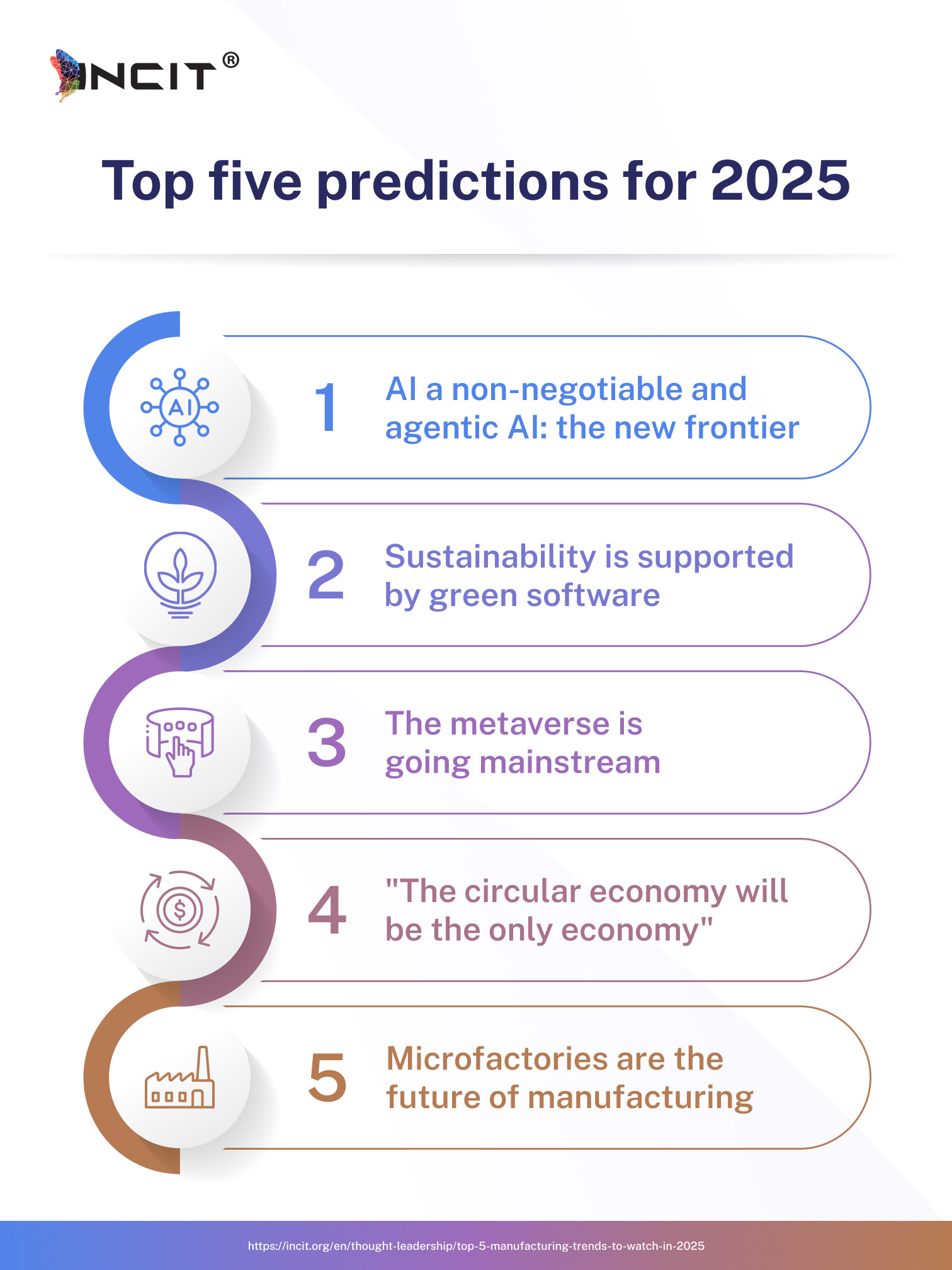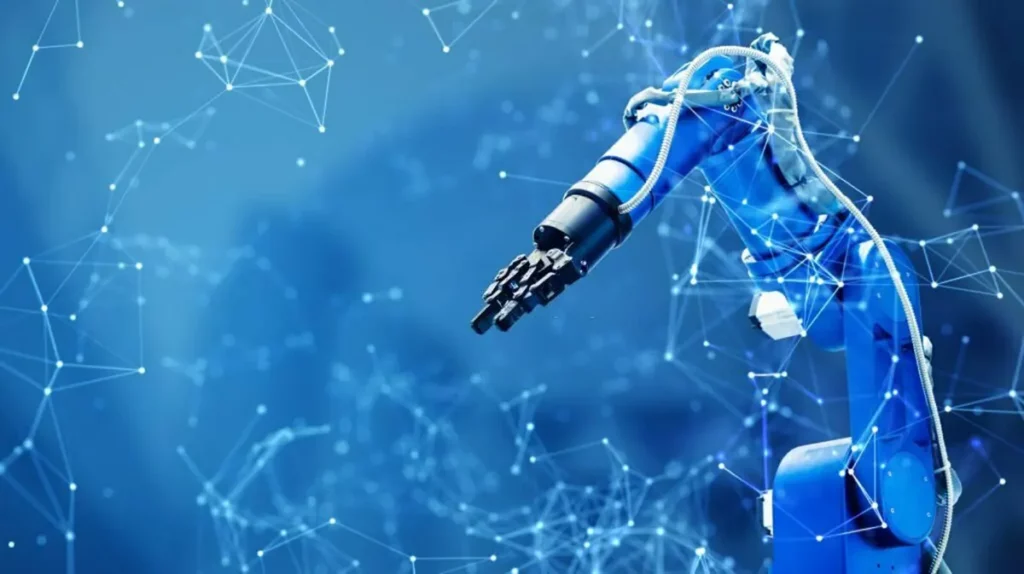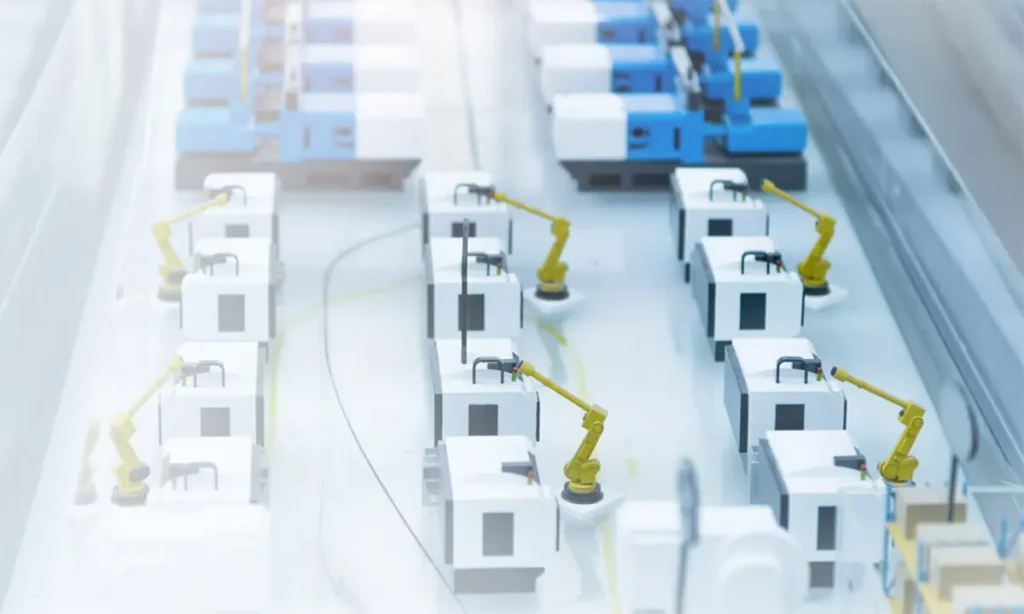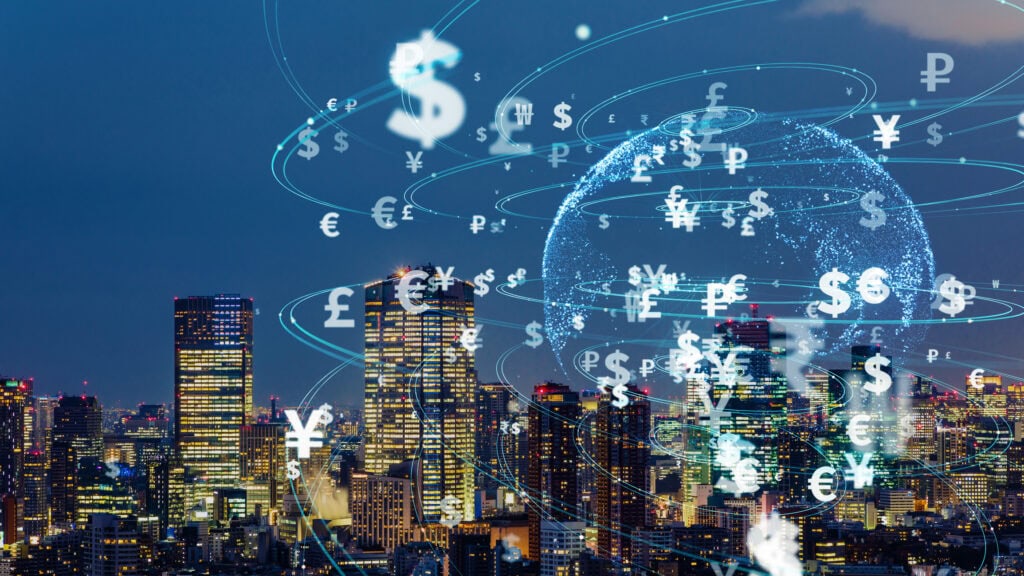當我們回顧 2024 年的趨勢時,我們意識到製造業正處於一個轉折點。隨著更加重視並專注於在各個方面取得進步——無論是數位化、顛覆性技術、卓越營運還是 ESG 績效——執行長必須克服關鍵挑戰,例如解決其遺留系統、基礎設施和過時的營運方式。
這些領域的進步至關重要,特別是我們預期 2025 年是階躍式變革的一年,漸進式變革已不再足夠,而是需要顯著提升績效,不僅要實現 工業 4.0 而且還成為 工業 5.0-準備好。
根據 Zion Market Research 的預測,全球工業 5.0 市場規模將在未來十年呈指數級增長,從目前的 14 億美元增加到 2032 年底的 14 億美元。儘管人們擔心機器將統治世界,但這個新時代將以人機互動、社會責任、勞動力再培訓、網路安全和維護資料隱私為特徵,凸顯人類在引領這一轉變中將發揮的關鍵作用。
雖然未來尚未確定,但2025年將與以往任何一年都不同。正如麥肯錫公司所說,這個行業不需要徹底改造,但執行長們的工作已經安排好了。他們不僅要專注於為Z世代和千禧世代重塑品牌,重新設計製造業務和運營,還要在永續性、創新和轉型等領域進行徹底的轉型。如果不這樣做,執行長可能會危及企業的競爭力和生存能力。隨著今年即將結束,我們認識到,變革,儘管在短期內往往是痛苦的,但在我們的行業中是必要的。
從工業 5.0 到自動化——塑造 2025 年的趨勢
隨著新年的臨近,通貨膨脹和政治緊張局勢已成為新聞焦點。外部世界將如何影響製造業?我們沒有水晶球,但透過審視市場並分析去年的趨勢(例如實施網路安全軟體以及加強合規性),我們可以建立製造業優先事項的框架,並為我們對2025年的預期提供參考。
工業 5.0 的興起將刺激人工智慧等創新解決方案,人工智慧將在轉型營運中發揮關鍵作用。人工智慧預計將影響商業的方方面面,從車間到會議,自動執行曾經由人類完成的危險任務,並使用生成人工智慧 (GenAI) 來總結會議。
隨著自動化佔據中心地位,人類是否會退居次要?隨著一些組織裁員並越來越依賴人工智慧和機器,製造業會走向崩潰、轉型,還是兩者兼具?答案很複雜。執行長必須接受工業 4.0 解決方案和智慧製造才能保持競爭力,但眾所周知,工業 5.0 將以人為本。
在這裡,我們考慮過去和未來的幾年,重點關注我們預測明年將出現的趨勢。
我們對 2025 年的重大預測
去年對執行長來說是充滿挑戰的一年,他們必須應對政治不確定性、通貨膨脹和複雜的監管環境。主要變化包括 歐盟企業永續盡職調查指令(CSDDD) 針對供應鏈、影響全球貿易的《購買美國貨法案》以及 歐盟森林砍伐條例(EUDR) 限制與森林退化相關的產品,增加了額外的壓力。許多法規將於 2025 年生效,要求執行長在艱難的環境下管理公司的同時,必須掌握新規則。
還有哪些因素必然會影響該產業的營運、生產和永續發展努力?以下是我們對 2025 年的五大預測:

1. 人工智慧是不可協商的、具有代理性的人工智慧
新的前沿。人工智慧還是非人工智慧,存在還是不存在。在這個複雜的環境中,需要人工智慧工具,但許多高階主管還沒有做好採用的準備,或者不知道它們是否會獲得投資回報。 Gartner 報告稱,超過 30% 到 2025 年底,GenAI 計畫將被放棄。此外,代理人工智慧正在成為下一個大趨勢,因為它可以規劃行動、做出決策並從過去的經驗中學習。此外,它還可以透過提高工作流程效率和預測性維護來優化製造流程。
推薦 – 透過留住和提升員工技能來平衡人工智慧和人類的力量。將人工智慧與傳統方法結合,同時確保關閉系統等控制措施以防範其固有的危險。此外,還要了解您正在採用的任何新的人工智慧解決方案,因為表面的知識在這個充滿挑戰的環境中不會對您有很好的幫助。
2. 綠色軟體支持永續發展
Gartner 警告稱,執行長們並未採用最具成本效益的永續 IT 計劃,並指出這些較便宜的選擇在企業中的採用率不到 30%。預計這一數字將迅速上升。其他綠色軟體建議包括移除「殭屍」裝置、遷移到雲端以及使用增強冷卻等未充分利用的措施。此外,Gartner 預測,全球 30% 的大型企業將整合軟體永續性,而 2024 年這一比例不到 10%。
推薦 – 綠色軟體支出的大幅成長表明,執行長們應該積極支持綠色舉措,因為綠色企業能夠帶來更高的員工工作滿意度、品牌認知度和投資回報,最終有望獲得更高的利潤。巴塔哥尼亞就是一個很好的例子。
3. 元宇宙正在成為主流
在製造業,預計到 2033 年,元宇宙將從 129.3 億美元成長到 3,370 億美元。元宇宙是 2024 年最熱門的流行語之一,它可以改變製造營運並推動創新,在藉助數位孿生獲得虛擬世界的支持下,實現更好的流程優化。元宇宙允許虛擬原型設計、增強協作以及豐富的訓練和模擬功能。
推薦 – 適應不適。向你的工程師和資訊長提出一些尖銳的問題,了解如何成功應用元宇宙,以確保其與你目前的IT基礎架構相匹配,或找到一個值得信賴的託管服務提供者來提供幫助。
4.“循環經濟將成為唯一的經濟”
Gartner 表示,這將在 2029 年實現。循環經濟是未來趨勢,製造業必須擁抱循環經濟,從現在開始減少浪費。根據 Zion Market Research 的調查,製造業產生的廢棄物約佔全球廢棄物總量的 50%。還有各種好處。據 Gartner 稱,如果供應鏈領導者採用循環經濟,到 2025 年,74% 的供應鏈領導者可以預期利潤會增加。
推薦 – 您在採用循環經濟方法方面是否落後?如果是這樣,您就落後了,但好消息是,您現在就可以開始行動。首先,您可以考慮優化資源效率、減少浪費(例如回收和再利用材料),或有效管理產品生命週期。
5. 微型工廠是製造業的未來
這些小型工廠利用尖端工具和解決方案,提供大型傳統工廠難以實現的新的靈活性和可擴展性。微型工廠也使用人工智慧、機器學習、大數據和其他創新技術,從而增強廢物消除、流程優化和個人化。
推薦 執行長們應該先評估現有流程,然後將微型工廠納入長期策略,因為它們在支持工業4.0方面發揮關鍵作用。微型工廠可以無縫整合物聯網、人工智慧和機器學習等先進技術,而且靈活敏捷,能夠提供更高水準的客製化服務,並符合環保製造的理念。
結論
CEO 們必須開始製定 2025 年的策略,如果他們還沒有這樣做的話。缺乏一個能夠整合策略的總體規劃 數位轉型、永續性和人工智慧將在未來一年阻礙企業發展。作為戰略總體規劃的一部分,人工智慧應該佔據重要地位。但要注意的是:執行長們應該克制對自動化、人工智慧和通用人工智慧的熱情,並認識到儘管這些尖端解決方案可能具有變革性,但它們仍然是新興事物,需要穩健的引導。
最後,企業領導者必須確保他們有足夠的預算來採用能夠有效支持永續措施的創新技術。不要害怕綠色領導力,因為它會帶來回報,從而提高永續發展績效,並為公司的整體永續發展目標做出積極貢獻。要了解有關 消費者永續性產業準備指數, 聯絡我們.
關於2025年五大製造業趨勢的常見問題解答
2025 年人工智慧製造業趨勢是什麼?
2025 年人工智慧製造的趨勢包括預測性維護、智慧自動化、基於電腦視覺的品質控制以及人工智慧驅動的供應鏈優化。製造商正在利用人工智慧來提高效率、準確性和決策能力。
2025年的未來產業是什麼?
2025年的未來工業將由智慧製造、人工智慧技術、永續生產和先進機器人技術塑造。工廠將變得更加自動化、數據驅動,並符合工業4.0的原則。
2025 年製造業的主要趨勢是什麼?
2025 年製造業的幾大趨勢包括人工智慧整合、數位孿生、循環經濟實踐、微型工廠和永續性。這些趨勢正在推動創新,並重塑全球生產體系。
2025 年人工智慧將如何改變製造業?
2025年,人工智慧將透過實現即時數據分析、自動執行重複性任務、預測設備故障以及增強供應鏈可視性來改變製造業。人工智慧將幫助製造商提高生產力並減少停機時間。
永續性在未來製造業扮演什麼角色?
永續性透過減少浪費、降低排放和推廣節能實踐,在未來製造業中發揮重要作用。 2025年,製造商將採用循環經濟模式和環保材料。
哪些技術將塑造2025年的製造業?
2025年,塑造製造業的技術包括人工智慧、機器人、物聯網、3D列印和數位孿生。這些創新正在推動智慧工廠和即時決策的發展。
為什麼智慧製造在 2025 年如此重要?
智慧製造在2025年至關重要,因為它利用自動化、人工智慧和互聯繫統來提高效率、降低成本並快速回應市場變化。它支持行業的創新和競爭力。
2025 年製造商面臨的主要挑戰是什麼?
2025年,製造商面臨的主要挑戰包括供應鏈中斷、網路安全風險、成本上升、勞動力短缺以及適應新技術。企業必須保持敏捷和韌性,才能保持競爭力。
2025年哪些產業預計成長最快?
預計2025年成長最快的產業包括清潔能源、電動車、先進製造業、生技和半導體。這些產業受到創新、數位化和全球永續發展目標的推動。


